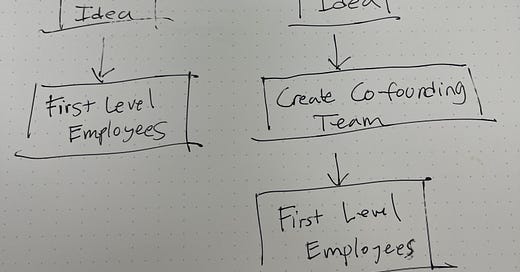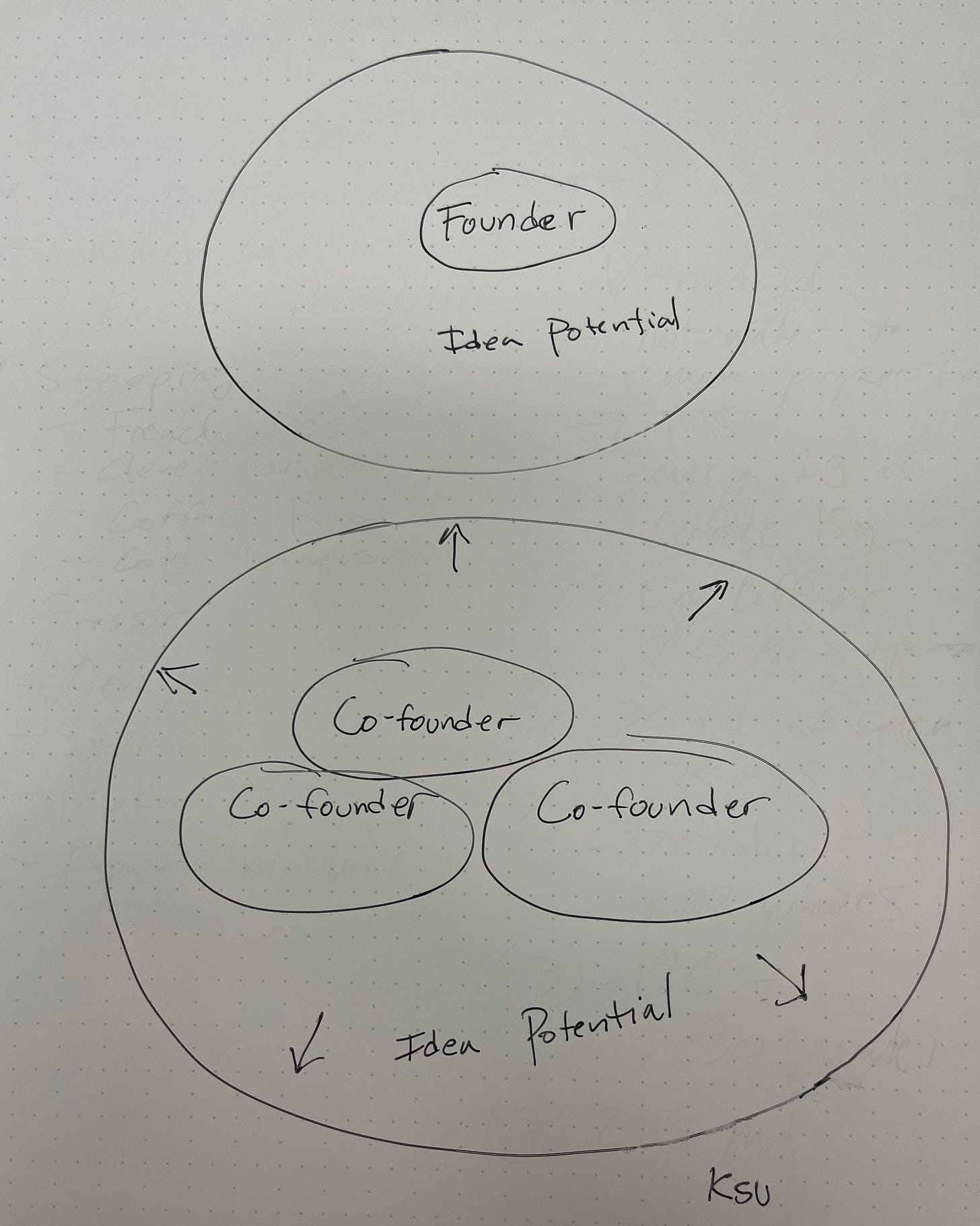A Margin of Safety Around Ownership
Establishing the Right Team: Choosing Between the Lonely Path and the Collaborative Path
I have always been curious about best practices around starting and scaling a company and have heard many versions from different successful founders. What I have learned in the last few years of entrepreneurship, and similar to investing, is that there is always a trade off between time and money. In every venture, one needs to manage different tasks in order to reach a common long term goal. Whether you do it yourself or with co-founders, there will be a significant amount of time spent to achieve it.
Building a company is about de-risking your idea, and everyone has a different view of what this really means. I think of this as the “reality” behind your idea. What hole are you filling? What makes your idea achievable? It comes down to your ability to execute and if it solves the problem you're addressing. People often say, 'I thought of that idea three years ago. I had it first.' But that doesn't matter. Ideas are everywhere and few take action to turn them into reality. It requires being honest with what you are capable of.
We all have different models of ownership and like to think about what it means to be a founder, but the real question should be: What ownership structure sets the stage for achieving greatness? While there are solo founders out there, like Elon Musk, Jeff Bezos, and Mark Zuckerberg, they're exceptions to the rule. Even they understood the importance of assembling a robust team early on, granting them significant ownership stakes in their respective companies.
“You need three things to create a successful company: start with good people, to make something customers actually want, and to spend as little money as possible"
- Paul Graham
When an idea is generated at the earliest stage, an entrepreneur has two broad paths, which I consider the bridge between idea generation and testing:
(1) The solitary path, where you begin alone and later build a team under your leadership,
or
(2) the path of seeking co-founders with diverse skill sets and working towards a common objective.
At the outset, the immediate goal is to achieve a minimum threshold of service or product, or what professionals refer to as the Minimum Viable Product (MVP)
The Lonely Path
If you believe you have the ability to venture off on your own, hats off to you. This approach offers distinct advantages, but eventually, you'll need to persuade skilled hires to join you and ensure their incentives align with yours. What are the advantages and disadvantages of this strategy?
Pros
The owner retains equity (ownership) as the company grows, motivating him/her to enhance value and generate substantial wealth.
Faster decision-making due to fewer decision-makers involved (less cooks in the kitchen).
Cons
Isolation (mentally exhausting)
Key-man risk (what happens if one dies or becomes incapacitated?)
Limited network
Increased time devoted to non-core skills, posing a time constraint (when addressing unfamiliar gaps)
Heavy reliance on delegation to meet goals (agency risk)
The major advantage is that the entrepreneur retains the majority of ownership in the company, potentially resulting in significantly greater wealth over time. However, this comes with the trade-off of having to handle critical tasks alone, while also ensuring that the right incentives are in place to motivate secondary employees. I call this a trade-off since the incentives of a founder and an early stage employee have a different level of alignment. One might say that an Equity Stock Option Plan (ESOP) is enough to incentivize a strong team, but there is no more powerful incentive than the equity position of a founder, which is significantly more than a share of ESOP. That said, this path is a lonely one and it requires a certain kind of person who is either (1) extremely skilled in many different parts of the business or (2) is a master delegator with a unique program to incentivize the most senior employees. These are unlike the challenges faced by a co-founding team, which leads us to the next topic.
The Collaborative Path
The collaborative path is different from the lonely path. In the lonely path, the initial step involves assembling a layer of primary employees to implement the plan. Although some (or all) may hold equity, it typically doesn't compare to the equity position of the sole founder. What differentiates the collaborative path is the first stage prior to senior level recruiting, and that is finding the right partners. One founder may have the initial idea, but it’s about sharing conceptualization with a group, and giving equal ownership and credit to each who adds value to the overall organization. It is about being honest with yourself about your own weaknesses, and bringing in other professionals from your network to de-risk certain aspects of the operation through aligned incentives, which is driven through equal ownership.
Pros
Stronger network for support during challenges or opportunities
Each founder concentrates on their specialized tasks (skills aligned)
A more supportive environment (less lonely)
Elimination of key-man risk
Reinforced leadership (more ownership support)
Stronger idea validation pool (more people to share stupid or brilliant ideas with)
Cons
Reduced equity share
Increased number of decision-makers can backfire and create and environment of disagreement (all stars have to align)
Managing Risk
Events compound in weird ways, and entrepreneurs have to accept the fact that there are risks that lurk which can have either a positive or negative impact on your company or even you as a person. Some can be extreme and can hurt the most prepared. In fact, that is the definition of risk. Negative outcomes that are considered a surprise.
In simple terms, risk is the possibility of something bad happening. Risk involves uncertainty about the effects/implications of an activity with respect to something that humans value (such as health, well-being, wealth, property or the environment), often focusing on negative, undesirable consequences.
- Wikipedia
In the book “Same as Ever” by Morgan Housel, there is a chapter where he brings up events that took unexpected turns from the smallest and most unexpected occurrences.
Here is an interesting snippet from the book…
The Battle of Long Island was a disaster for George Washington’s army. His ten thousand troops were crushed by the British and its four-hundred-ship fleet. But it could have been much worse. It could have been the end of the Revolutionary War. All the British had to do was sail up. It could have been the end of the Revolutionary War. All the British had to do was sail up the East River and Washington’s concerned troops would have been wiped out. But it never happened, because the wind wasn’t blowing in the right direction and sailing up the river became impossible.
Historian David McCullough once told interviewer Charlie Rose that “if the wind had been in the other direction on the night of August twenty-eight [1776], I think it would have all been over.
“No United States of America if that had happened?” Rose asked.
“I don’t think so,” said McCollough.
“Just because of the wind, history was changed?” asked Rose.
“Absolutely,” said McCullough.
This story is shocking because the slight change of the wind could have changed the entire history of the United States. How does this relate to entrepreneurship? We have the same type of unforeseen outcomes and they can occur from the smallest incidents. The only way to manage is to prepare for the worst and have the right team in place.
There were a couple of incidents in our bread business where things could have taken a drastic turn. One incident occurred in our commissary when a disruptive neighbor began complaining about truck noise, despite our location in a commercial area. It reached a point where he entered our commissary and threatened our staff. These were bold threats that scared the living daylights out of our team. Long story short, we were able to settle and the neighbor’s father apologized for everything. What would have happened if that neighbor had a gun? or if he went beyond threats and complaints? You can only imagine how this could have impacted the direction of our company. After this incident, the founders and management team sat down to discuss it. We realized that such risks are unforeseeable and fall under what is known as a "black swan" event. All we can do is remain vigilant and prepared for any eventuality.
As much as there is risk, there is also luck that can benefit the business. Initially, our vision was to make higher quality bread accessible to the mass market, while making coffee a complement to the business. We did not expect coffee to be extremely popular at the mass market level, but it was. We shifted to brewed coffee (from concentrate) and it was accepted by the market. It turns out that we are the only mass market bread company that provides real coffee (in the Philippines), making us a bakery with a “bread and (real) coffee” offering. Did we plan for this when we initiated our idea? No. Did we foresee that coffee would be a large component of the business? No. It came as a surprise and we accepted it and had to adjust to cater to the demands of our customers.
The same way luck is created by positioning oneself the right way (being curious, reading, and expanding your network), it goes the same with downside risk. Building a robust team and fostering an environment with a strong margin of safety is important. Beyond insurance, having a strong co-founding team with diverse skills and the right connections and skillsets can mitigate the impact of unforeseen risks.
ABOUT THE AUTHOR
Keenan Ugarte is Managing Partner at DayOne Capital Ventures, an independent private holding company based in the Philippines that partners with entrepreneurs across a wide range of industries. He is the Co-Founder and Director of The Independent Investor.





